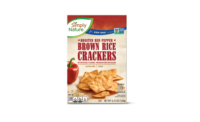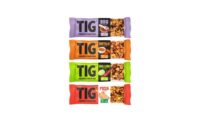Satisfy Your Cravings
By Jenny Welbel
Private label cookie, cracker, and snack manufacturers struggle to find a balance between nutritious and delicious.
As one strolls through the snack aisle, there are a plethora of options to satisfy any craving. Whether a consumer seeks a salty treat, an organic snack bar or an energy boost in the middle of the day, the industry offers many choices. However, not every segment in the cookie, cracker and bar category is as successful as the assortment might suggest.
“The cookie segment seems lackluster … but breakfast bars, granola bars, fruit-filled bars and snack bars are still showing solid growth,” says Bill Ross, owner of Bloomfield Bakers, Los Alamitos, Calif.
The dollar sales figures for the past 52 weeks in the cookie, cracker and bar category echo Ross’s point of view. In fact, the total bar category has dollar sales totaling $1.87 billion, with private label bars comprising a little more than half of the sales at $96.7 million, according to Information Resources Inc. (IRI), Chicago.
On the other hand, private label cookies and crackers are not experiencing the same success as their snack counterparts. The total cookie category generated sales totaling $3.4 billion, yet private label cookies only make up 8% of that category, reports IRI, which tracks primarily food sold in supermarkets. In addition, private label crackers represent only 6.8% of the $3.2-billion category.
Healthy and On-the-Go
However, there are a number of factors that contribute to the flurry of new product activity in bar category. One prominent reason for the success of bars is that they accommodate the fast-paced lifestyle that so many individuals have today.
“With consumers’ increasingly busy schedules, having an on-the-go alternative that provides real nutrients satisfies a real need for people,” says Lorraine Hood, vice president of Petaluma, Calif.-based Barbara’s Bakery.
Whether individuals seek a quick pick-me-up or are looking for a breakfast supplement, the private label bars category is able to provide it all. The two largest segments of the bar industry are granola bars and breakfast bars. Granola bars make up 66% of the category, while breakfast bars comprise 32% of the category, according to IRI. The granola and breakfast bar segments are flourishing because they offer on-the-go individuals the nutrients and vitamins they desire in a quick breakfast or snack.
Specifically, granola bars offer a healthy snack option that enables individuals to refuel between meals, while breakfast bars offer a convenient replacement for the most important meal of the day.
| Cookies, Crackers, and Bars Performance | ||||||
| Dollar Sales (in millions) | % Change vs. Yr. Ago | Dollar Share | Unit Sales (in millions) | % Change vs. Yr. Ago | Avg. Price Pet Unit | |
| Snacks Bars/Granola Bars Total | ||||||
| Total private label | $96.7 | 25.0% | 5.2% | 46.5 | 26.2% | $2.08 |
| Total category | $1,866.0 | 5.3% | 100.0% | 854.8 | 5.0% | $2.18 |
| Breakfast/Cereal/Snack Bars | ||||||
| Private label | $31.3 | 22.9% | 5.4% | 15.0 | 27.9% | $2.09 |
| Total subcategory | $575.5 | 7.0% | 100.0% | 210.7 | 6.9% | $2.73 |
| Granola Bars | ||||||
| Private label | $63.3 | 29.9% | 9.9% | 30.2 | 30.7% | $2.10 |
| Total subcategory | $638.1 | 10.6% | 100.0% | 262.1 | 8.1% | $2.43 |
| Nutritional/Intrinsic Health Value Bars | ||||||
| Total private label | $.84 | -27.3% | 0.2% | .67 | -33.9% | $1.27 |
| Total subcategory | $515.5 | -6.7% | 100.0% | 320.8 | -2.7% | $1.61 |
| Rice Snack Squares | ||||||
| Private label | $1.2 | -38.3% | 0.9% | .63 | -36.7% | $1.83 |
| Total subcategory | $129.2 | 25.9% | 100.0% | 57.1 | 33.5% | $2.26 |
| Crackers | ||||||
| Total private label | $215.9 | -0.6% | 6.8% | 159.8 | -3.5% | $1.36 |
| Total category | $3,182.2 | -1.5% | 100.0% | 1,445.3 | -3.5% | $2.20 |
| Cookies | ||||||
| Total private label | $291.1 | -3.0% | 8.5% | 164.3 | -7.5% | $1.78 |
| Total category | $3,427.6 | -1.7% | 100.0% | 1,535.9 | -3.7% | $2.23 |
| Source: Information Resources Inc. Total supermarket, drug and mass merchandiser sales for the 52 weeks ending May 21, 2006, excluding Wal-Mart. | ||||||
Furthermore, echoing a major trend impacting nearly every salted snack and baked goods category is the emergence of products with organic and natural ingredients in the bar arena.
“Natural and organic products are going to become a way of life,” says Regina Tator, director of corporate brands, Price Chopper Supermarkets, Schenectady, N.Y.
“Traditional retailers are looking toward organics to grow the business,” Ross adds. “Organic allows manufacturers and retailers to create excitement in the category and [raise] margins.” In addition to organic and natural ingredients, Ross believes that, “‘no corn syrup’ will be the next health target related to obesity.”
However, individuals still are looking for bars that will satisfy their sweet tooth. A number of national brands have spurred a growing trend toward the sweet and salty taste combination. To accommodate this niche, General Mills’ leading brand, Nature Valley, has introduced a line of Sweet and Salty Nut granola bars, while Kellogg Co. is preparing to launch its own Crunchy Nut Sweet & Salty bars.
Bloomfield Bakers also is accommodating those sweet cravings by adding drizzles of icing and granola toppings to their snack bars, Ross says.
Adding any inclusions, whether they are nuts or fruit pieces, can transform a “me-too” product into a snack that differentiates itself from the competition. In addition to adding value, thus creating a premium position for the snack item, nuts and fruit can offer nutritional benefits, which can provide yet another selling point.
Indulge Yourself
Although the snack bar category is growing, the cookie category has remained fairly stagnant over the past 52 weeks. One of the biggest reasons is the public’s concern with trans fat — an issue brought to the forefront through intense media coverage in late 2005. As of January 1, 2006, the Food and Drug Administration requires manufacturers to list trans fat values on product packaging. In response, manufacturers have scurried to reformulate products to contain 0 gm. of trans fats, though many have found it to be quite challenging.
“Trans fat reformulations have impacted the cookie and cracker categories. [Reformulated] national brands, such as Oreo, do not score as high as the original product with consumers,” according to Ross.
Tator also has doubts. “At the end of the day, I am not sure that you can make a good Oreo without trans fat,” she says.
The fact of the matter is that “consumers are becoming more aware and are reading labels,” Ross says. Individuals want to know that they are eating products that are good for them and that fit into a healthy lifestyle. As a result, packages containing a serving size comprising only 100 calories have become a popular option for many individuals, especially given the intense marketing push by leading national brands putting all sorts of cookies and crackers in 100-calorie packs. The single-serve packages enable individuals to keep track of what they are eating and yet still indulge. Many national brands offer a variety of 100-calorie packs, and some private label manufacturers say they are focusing efforts on 100-calorie packs to keep up with the leading brands.
However, Tator is not sure the trend will continue. “They have had their day in the sun,” she notes. “No one is making them in private label.”
Regardless of whether the 100-calorie packs will continue to succeed, there is one trend that no one can ignore: upscale cookies.
“Most of our success is doing upscale items, such as Central Market Classics,” Tator says. “All of our growth in cookies and crackers is because of that line.” Central Market Classics has two new upscale items: the Triple Chocolate Chip Cookie and the Cranberry White Chocolate Cookie.
According to Tator, “People still like to indulge occasionally, which is why it is the upscale cookies that are causing the growth. People either love them or hate them, but when they love them, they come back for more.”
“The upscale premium cookie is growing,” echoes Brent Bumpers, president of Brent and Sam’s Cookies, North Little Rock, Ark. “It is another attempt to capture brand loyalty and enhance the demographics of the shopper.”
The bottom line is that many individuals will indulge regardless of what the ingredient list contains, while others will let the nutrition facts guide their diet.
“People are still looking for something that tastes good, while some people will be obessed with trans fat,” Tator says.
In addition, “Some people just want the best-tasting cookie and cracker they can put in their mouth, and they don’t care about the health benefits, while others are looking at the natural or organic way of life throughout their diet and will pay more for it,” Ross explains.
A Marketing Movement
Despite recent concerns over trans fat in cookies and crackers and the increase of natural and organic ingredients in snack bars, everyone agrees that in order for these products to be successful, they have to be marketed properly. Private label snacks need to “get off the shelves and into end caps and other areas of the store, such as pallet displays and checkouts,” Ross says, emphasizing the importance of impulse purchases.
“You need a prominent display in front of the store,” Tator explains. “Why are we expecting our customers to find these? Put them out there, and get people to try them on the front side.”
In order to compete with the national brands, “retailers need to treat their private label brand like a national brand, advertise the product lines and display the product like the national brands,” Ross says. “That is when sales will soar.” SF&WB
Editor’s Note: Jenny Welbel is contributing editor to PLBuyer, a Stagnito Communications publication. This article first ran in the July issue of PLBuyer.
Pricing Power Promotes Brands over Private Label
Private label has gained share in terms of units sold in supermarkets. However, when it came to the almighty dollar, store brands saw their share decline to 16.1% in 2005 compared with 16.2% the year before, according to the Private Label Manufacturers Association and Chicago-based Information Resources Inc.
The New-York-based PLMA attributed the dollar share decline to the price increases that many national brands were able to get over the last year as energy, commodities and health care costs continued to rise. In food categories, which together account for four out of five items sold in the supermarket channel, dollar volume of private label products inched ahead at 0.1% while national brands increased 0.9%, the PLMA reported in its 2006 Private Label Yearbood, which used IRI data for the 52 weeks ending December 25, 2005.
Across supermarket and drug channels, private label fresh bread and rolls products comprise 26.7% of the $8.2 billion category, a loss of 0.2% in share as branded producers rolled out more super-premium baked goods that commanded a higher price point.
Private label pastries and doughnuts now account for 18.0% of the $1.6 billion category, up 0.6% in dollar share from the previous year. Meanwhile, private label salted snacks account for 4.9% of the $7.2 billion category, up only 0.1% dollar share in 2005 over 2004.





